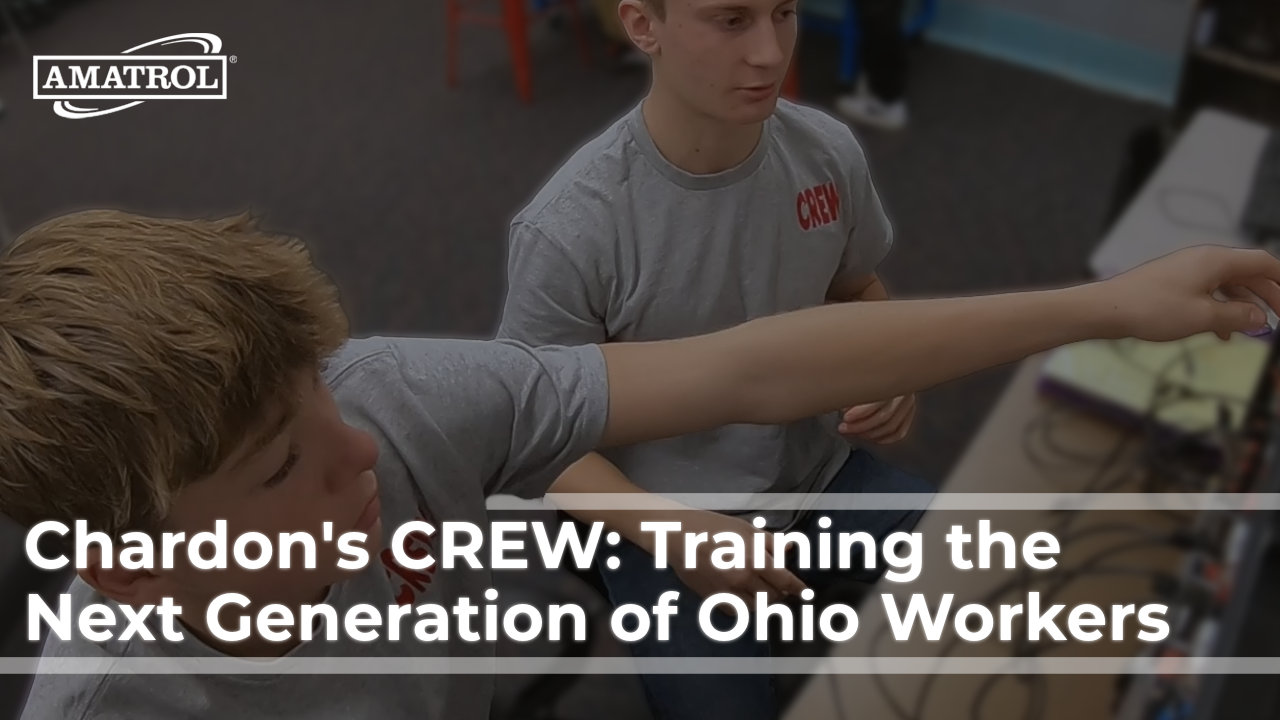How do you effectively prepare high school students for the manufacturing jobs of today and tomorrow? If you’re Chardon High School career and technical education (CTE) instructors Tracey Britt and Kim Butala, you partner with Amatrol and Buckeye Educational Systems to create what Taneisha Cordell from ABC News 5 Cleveland calls “a technology playground.”
According to Britt, “Four years ago, [Kim] and I came together and really felt like we could do a little bit more for the students here at Chardon High School. We decided to try a new program and luckily our district was on board and that’s how the CREW started. It stands for Creating Reliable Educated Workers. We really just started as a classroom and after diving in and really getting to know the community in a different way, we found out that there was a huge need in our area for manufacturing.”
Britt and Butala based The CREW on Amatrol’s Industry 4.0 Fundamentals, a high school-based program that prepares students for high-paying Industry 4.0 careers in local industries. The students that make up The CREW study subjects that range from fundamentals like AC/DC electrical wiring, hydraulics, and pneumatics up to advanced smart manufacturing topics like mechatronics, smart sensors, programmable logic controllers, and more!
Amatrol’s training tools combine comprehensive eLearning curriculum with hands-on trainers that feature real industrial equipment that students will encounter in the modern workplace. To get a glimpse of The CREW’s “technology playground,” check out this video of Chardon High School CREW members in action:
How do you measure success in a modern high school CTE program? There are many criteria you could use, but instilling a love of learning is certainly one of them. Students in The CREW are enjoying learning hands-on skills they’ll use in the future.
For example, Chardon student Caden Bednar says, “I really enjoy being part of this program, because it gives us a lot of great opportunities while learning about machines and programs that interest us.” Fellow student Richard Nemetz calls The CREW “a genius move” that he “never would’ve thought…would happen to me.”
Being part of The CREW isn’t just about having fun with new technology, however. The program teaches students valuable troubleshooting and critical thinking skills. Chardon student Sawyer Smith says, “It’s not only teaching me about the actual equipment. It’s teaching me problem solving, working with others.”
Fellow student Will Boehnlein echoes Smith’s view: “It’s fun, because it’s almost like a puzzle…you’ve got to figure it out.” Britt notes that “Watching them grow, watching them struggle, work through the struggle, find that grit within themselves, has been amazing.”
These skills will be critical when these students enter the modern manufacturing workplace. Fortunately, they get a taste of what that’s like as part of The CREW. Britt and Butala like to take students on visits to local manufacturers so students can get a firsthand impression of the many career options available to them.
“We do a lot of visits,” says Britt, “and we go out and we see what’s happening. And it’s great, because as we walk through, we’re like ‘Hey, you see that? Do you see that sensor?’ Everything that’s happening in here, they’re able to see out there and they’re able to make those connections.” Student Bednar agrees with Britt: “What we’re learning here will actually be on real life job sites that we may be working in.”
Britt and Butala don’t have to convince students that what they’re learning has real-world applications. They have the success stories to prove it. According to Britt, “We have four young men who were in our program last year…We were able to place them in manufacturing. They were all seniors…Those four young men, once graduation day hit, they were employed full time. They’ve continued to grow within their positions, within their companies. They’re all fully employed. And we feel that’s a huge success.”
For students who might want to pursue a two- or four-year degree rather than immediately enter the workforce, Britt and Butala have added another layer to the program that will benefit students immensely and possibly earn them college credit while in high school: certifications from the Smart Automation Certification Alliance (SACA).
SACA’s certifications are industry-driven, developed for industry by industry. They represent the skills that industry needs related to a wide variety of modern advanced automation technologies. Students with SACA certifications can often earn college credits and prove to potential employers they possess the skills to succeed.
Britt says, “SACA has been fantastic…a lot of our kids never saw themselves going to college, so if we can pair the hands-on and those credentials with some college credits for them, it’s opening up a whole new door. Now they’re seeing themselves in a different light, which I think is what this is all about.”
Indeed, students earning SACA certifications has taken The CREW to another level. According to Britt, “We were able to get 24 students SACA credentials last year here in the classroom, so that’s another huge success for us and they’re able to take those out into the community. And our community partners are really interested in credentialing and what the kids are bringing to them.”
Putting together a program like The CREW doesn’t come without a lot of hard work, much of it taking place outside the classroom and beyond normal work hours. The students of Chardon High School are lucky to have committed instructors like Britt and Butala. “We love what we’re doing and we are very passionate about it,” said Butala. “It comes with the job.”
If you want to provide your students with an experience similar to The CREW, contact an expert at Amatrol today to learn more about its comprehensive high school programs, including Industry 4.0 Fundamentals and IGNITE: Mastering Manufacturing. Also, be sure to check out this video from ABC News 5 Cleveland about the Chardon High School CREW program:





